 |
|

|
 |
TABLE of CONTENTS
 |
New Hwy 43 Bridge opens with community celebration, marching band |
By Mike Dougherty, District 6 public affairs coordinator

The Winona Senior High School Marching Band led the crowd across the new Hwy 43 Winona Bridge during a dedication ceremony Aug. 27. Photo by David Gonzalez |
Strike up the band! The new Winona Bridge is open for traffic.
Nearly 500 Winonans and area residents walked and bicycled on the new Hwy 43 Winona Bridge Aug. 27. The Winona Senior High School Marching Band led the crowd from the crest of the bridge to the foot to celebrate its opening.
Commissioner Charlie Zelle congratulated the MnDOT team, the community and contractor for its collaborative work.
“Through great collaboration and cooperation, we have been able to move this project along and ensure that the effect on downtown businesses has been as minimal as possible,” Zelle said. “Because we have been able to use the current structure while building the new structure, we were able to reduce the traffic impacts and avoid a long detour.”
The new bridge is 2,294.5 feet long and stretches across the Mississippi River to Latsch Island in Minnesota, upstream from the existing bridge. Construction of the new bridge started in July 2014.
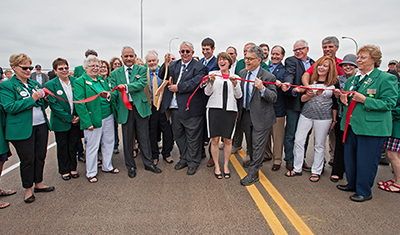
Winona Mayor Mark Peterson cuts the ribbon during a dedication ceremony Aug. 27 for the Hwy 43 Winona Bridge. Next to Peterson during the ceremony were state Sen. Jeremy Miller of Winona, U.S. Senator Amy Klobuchar, state Rep. Gene Pelowski of Winona, U.S. Senator Al Franken, Commissioner Charlie Zellie, U.S. Rep Tim Walz and state Rep. Steve Drazkowski of Mazeppa. Photo by David Gonzalez |
Zelle led a series of speakers at the event on the bridge that included U.S. Senators Amy Klobuchar and Al Franken, Congressman Tim Walz, state Sen. Jeremy Miller and state Rep. Gene Pelowski. Winona Mayor Mark Peterson greeted everyone and Winona’s Poet Laureate Ken McCullough read a poem for the occasion.
Peterson applauded the role Winona had in the development of the bridge.
“Bridges bring communities, states and countries together,” Peterson said. “They’re linkages that are vital, and we’re grateful that we had a role in shaping this project.”
This was MnDOT’s first use of Construction Manager/General Contractor method, which aided speed and flexibility of design and construction.
The new bridge with roadway cost $80 million, while the existing bridge with site work is estimated to cost $58 to $65 million depending on final plan with approach spans.
Later in the day, the bridge opened for traffic, while residents continued to use the new pedestrian-bicycle walkway to admire the Mississippi River Bluffs and the views of Winona’s historic downtown buildings. Traffic travels from Wisconsin into Winona on the new bridge and from Winona to Wisconsin on the existing bridge.
The existing bridge will close to traffic later in September for rehabilitation work that’s expected to be complete by fall 2019 or spring 2020. |
 |
|

|
 |
TABLE of CONTENTS
 |
MnDOT staff engage with record number of State Fair visitors; participate in daily parade |
By Dana Hernandez
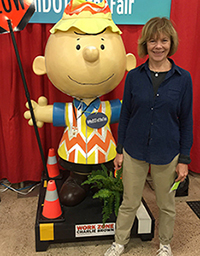
Lt. Gov. Tina Smith visited the MnDOT booth at the State Fair and posed with Work Zone Safety Charlie Brown. Photo by Judy Jacobs |
The annual Great Minnesota Get Together saw a record number of visitors, with overall attendance of the 12 days reaching nearly 2 million visitors this year.
The theme for MnDOT’s booth, continued from last year, focused on telling Minnesota’s transportation funding story and the need for a transportation system to improve the economy and quality of life throughout the state. The display also celebrated the 60th anniversary of the interstate system, featuring many black and white photos showing the construction of different segments of the interstate. The Hwy 53 Relocation project, designed for a 100-year life and which will be the tallest bridge in Minnesota when completed next year, was also a highlight of the display.
Commissioner Charlie Zelle was at the booth and encouraged MnDOT Facebook followers via video to visit and pick up a 2015-2016 state highway map. Sue Mulvihill, deputy commissioner and chief engineer, also spent time at the booth listening to visitors and providing them with transportation information.
More than 80 employees volunteered for shifts at the booth and handed out approximately 18,000 maps. Other handouts offered include Minnesota GO magnets, litter bags and 511 travel information cards.
The “star of the show,” at least to the younger crowds, was Work Zone Safety Charlie Brown. MnDOT first introduced him to fair goers in 2003.
“We had a lot of success featuring Charlie Brown at the exhibit this year. Children enjoyed putting on safety vests and getting a picture with him, and their parents were able to engage with MnDOT during our most visible event of the year,” said Libby Schultz, state fair coordinator, Communications.
Visitors were encouraged to post their photos to social media using the hashtag, #MnDOTattheFair. Many shared and posted the hashtag on both Facebook and Twitter.
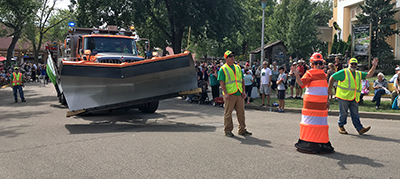
A MnDOT snowplow and Maryland Avenue Truck Station employees (from left) Rick Ludwig, Ricci Lepinski (driving), Joe Czaplewski and Steve Hardy participated in the State Fair Parade Aug. 30. Laurel Janisch, Public Engagement and Constituent Services, marched in the orange cone costume. Photo by Kristi Loobeek |
MnDOT also had a presence in the Eco Experience building. Office of Transit employees worked to promote the different modes of transportation and handed out bike maps to visitors.
Apart from the exhibits, a snowplow, a safety cone mascot, the Minnesota GO Mobile and other safety-vested employees came together to participate in two of the daily State Fair parades.
“The Minnesota State Fair is a great opportunity for MnDOT to meet its customers,” said Kevin Gutknecht, Communications director. “Every year, we have great employees who set up our fair display as well as volunteers who come out, work at the fair and explain what MnDOT does. This was a great fair, and we look forward to next year.” |
 |
|

|
 |
TABLE of CONTENTS
 |
Employees are encouraged to participate in World Car Free Day |
|
By Dana Hernandez
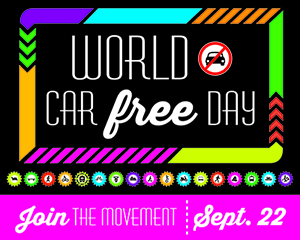
Car Free Day encourages individuals to walk, ride the light rail or public bus lines, bike, carpool or vanpool versus driving alone on Sept. 22. |
Walking, riding the light rail or public bus lines, biking, carpooling and vanpooling are other options for traveling to and from work instead of driving a single occupancy vehicle. Every Sept. 22 is World Car Free Day, which encourages people to use these modes of transportation versus driving alone. This year, ABC Ramps, owned by MnDOT, is partnering with Move Minneapolis to promote this international day within the Twin Cities. However, MnDOT employees statewide can also participate.
“MnDOT is a multimodal agency,” said Lisa Austin, ramp coordinator. “It is important for all employees to know a little bit about all the modes for perspective. If everyone were to drive alone it would contribute to faster deterioration of our roads and to air pollution. There are options for other ways to travel.”
This car free event can be traced as far back as 1956 with some countries making Sundays car free. Structural requests and national campaigns for such a day followed. The European Commission established a car free initiative throughout Europe in 2000. In 2015, Paris launched its first car free day, which involved banning vehicles, except for buses, taxis, garbage and emergency trucks from the center of the city.
Cities in the U.S., such as Washington, D.C., have also started promoting World Car Free Day.

Riding the bus is one of the other modes of transportation encouraged for Car Free Day Sept. 22. Photo by David Gonzalez |
Using other modes of transportation lessens traffic congestion and reduces the amount of carbon monoxide released into the atmosphere.
According to the Minnesota Transportation Performance Report, MnDOT focuses on providing alternatives to help reduce congestion. Twin Cities’ transit ridership has increased since 2005 and increased since 2011 in greater Minnesota.
While the region’s population and economic activity grow, congestion is expected to increase. Motorized vehicles are responsible for more than half of all carbon monoxide and hydrocarbon emissions in Minnesota, according to the Pollution Control Agency.
A significant increase in air pollution is likely with more cars on the road. This is concerning because the MnDOT performance report states that air pollution causes breathing problems and contributes to other health conditions.
Austin said the goal of Car Free Day isn’t to make any drastic changes in 24 hours, but to create awareness of other modes of transportation so people can develop the potential to frequent them over time, which would help to reduce their carbon footprint.
“Sept. 22 encourages people and allows for them to plan on being car free for one day, and maybe when they see how possible it is, they will consider doing it more often.” said Austin. |
 |
|

|
 |
TABLE of CONTENTS
 |
Maintenance employees’ inventive ideas make a difference |
By Sue Roe

Jim Phelps, Blue Earth Truck Station, and Loren Michaels, now retired from the Mapleton Truck Station, use the mastic lute skid to control the application of mastic on cracks. Mastic is a polymer-based adhesive. Photo by Steven Blaufuss |
Editor’s Note: This is the second of two stories about how MnDOT maintenance employees help find solutions to everyday problems. The the first article here.
All around the state, maintenance employees use their ingenuity and imaginations to turn problems into more efficient and safer ways to complete their work.
Often these creative ideas come in the form of small in-house built devices that are stand alone or used as attachments on other pieces of equipment.
The creations are captured within the Office of Maintenance’s new Technology Transfer initiative, which offers a fresh perspective of collecting and sharing grassroots ideas with maintenance field personnel.
“The unique thing about the program is that it allows opportunities for operators in the field to put a voice to their thoughts and share their creations with everyone,” said Steven Blaufuss, who served as project director during a three-year mobility assignment.
His job was to seek out the innovations and work with districts to make sure the ideas are used in a cost-effective way.
Blaufuss compiled the ideas into a catalog that contains 30 one-pagers about each device that was created or discovered. Ideas are categorized into snow and ice-related, patching and miscellaneous.
“These projects were self-driven by employees wanting to make a difference in their work environment. This program helps to extend that reach and allows for those ideas to be implemented statewide,” said Blaufuss, who now works as the statewide maintenance work zone and operations specialist. “This is their opportunity to provide a better work environment all across the state.”
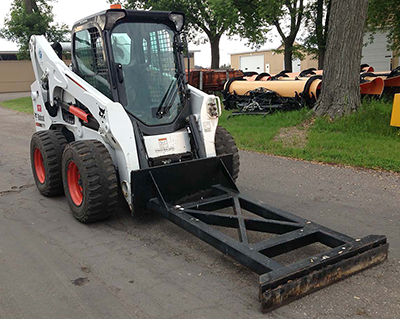
District 3 workers built a guardrail screed creeper to level off areas of washouts underneath guardrails. It replaces the use of rakes and shovels and reduces overexertion risks. A plow cutting edge is used as the adjustable leveler. It can also be used to level water shedding. Photo by Steven Blaufuss |
Baudette Truck Station employees in District 2 were getting eye fatigue and headaches from the strobe lights used on plows during night-time snow plowing operations. The strobe lights have a tendency to reflect off the mirrors and back into the cab. Employees used an old road sign to deflect the light coming off the strobe. Cost to make the device was $10.
In District 3, workers built a guardrail screed creeper to level off areas of washouts underneath guardrails. It replaces the use of rakes and shovels and reduces overexertion risks. A steel plow cutting edge is used as the adjustable leveler. It can also be used to level water shedding. The attachment fits on a skid loader. Cost to build was $500.
The mastic lute skid, developed in District 7, allows operators to control the application of mastic on a long stretch of longitudinal cracks with minimal effort. Mastic is a polymer-based adhesive used to make road surface repairs. The skid results in a cleaner end product, reduces overexertion and is easily attached and removed. Cost to build was $200.
Blaufuss said every MnDOT district is now using the mastic lute skid and a vendor is producing them for other states.
“This was the creation of a device that never existed before and the fact that a vendor is now making them gives you an idea of the scope of the projects that MnDOT employees can create,” he said.
At the Mankato Truck Station in District 7, workers came up with an idea to use a convex mirror to help get a better view of the underbody and the amount of scraping output. The mirror also helps workers determine the position of their truck easier by improving the visibility of the centerline stripes during scraping. The mirror uses an existing mirror mounting to attach to the truck. Cost to make was $13.
Although the duties of Blaufuss’ current position don’t require him to formally lead the Technology Transfer program, Blaufuss said he will continue to promote it and keep the momentum alive.
“The perception of this program is that it may be confined to a specific life-cycle. Because of the amount of ideas that were found in the past three years, it may be a few years before we see another position funded to formally lead a new program,” he said.
“MnDOT maintenance workers take their jobs to heart and have a lot of personal pride in what they do,” Blaufuss said. “Solving problems comes naturally for them.” |
 |
|

|
 |
TABLE of CONTENTS
 |
Employees share expertise at Public Works Expo |
|
By Micheal Foley, Research Services
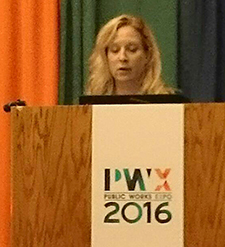
Jennifer Zink, principal bridge inspection engineer, presented at the Public Works Expo about her use of drones in bridge inspection operations. Photo courtesy of the American Public Works Association |
Thousands of public works professionals from around the world visited Minnesota Aug. 28-31 for the annual Public Works Expo put on by the American Public Works Association at the Minneapolis Convention Center.
PWX featured more than 125 education sessions and a 90,000-square-foot exhibition floor where public works industry leaders showcased the latest products, services and technologies.
Among the presenters for the education sessions were several MnDOT employees who highlighted the agency’s work in a variety of areas.
Winter maintenance
Jakin Koll, road weather forecast coordinator; Michael Kowski, maintenance resource engineer; and Sue Lodahl, assistant maintenance engineer; served on a lightning round panel titled MnDOT’s Approach to Winter Maintenance. They shared three state-of-the-art operational practices MnDOT uses to stay ahead of Minnesota’s winter storms.
“I presented with co-workers on the area of winter maintenance in a "Lightning Round" session,” said Lodahl. “Lightning Rounds are short presentations and allow attendees to get a taste of a topic and also attend a variety of sessions. Great attendance at the session and lots of questions. I have attended these APWA conferences in the past and always find they are educational and informative.”
Bridge planning
Solomon Woldeamlak, hydraulics engineer; and Dustin Thomas, bridge construction engineer; spoke about MnDOT’s bridge replacement and improvement management system that uses risk assessment methods to determine a bridge’s probability of service interruption and assigns a score for its relative priority for replacement or improvement.
Drones
Jennifer Zink, principal bridge inspection engineer, shared information about her ongoing research project to evaluate the use of drones in bridge inspection operations. The presentation detailed the effectiveness of the drone technology, current and proposed FAA rules regarding drone safety and a cost comparison between using drones and using traditional inspection tools.
Stormwater assets
Barbara Loida, municipal separate storm sewer system engineer, was part of the Public Works Stormwater Summit, which featured case studies about cutting-edge concepts and technologies that have created a special focus on stormwater asset management strategies and planning tools. Loida presentation examined MnDOT's stormwater asset management system and impaired waters tracking tool.
Workplace safety
DeLorah Curry, Human Resources, shared the workplace protocols and training materials for MnDOT’s Active Shooter Preparedness and Response Program.
|
 |
|

|
 |
TABLE of CONTENTS
 |
WIG 2.0 surveys coming soon |
By Tracy Hatch and Sue Mulvihill, deputy commissioners
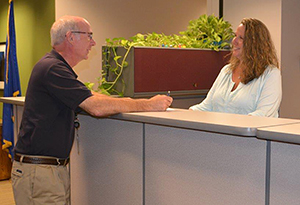
Serving our internal customers: Terri Nygaard, executive assistant for the Operations Division, answers a question from Ed Idzorek, portfolio manager. Photo by Judy Jacobs |
As you know we recently launched our second Wildly Important Goal aimed at earning trust and increasing transparency through a customer-centered organization in which we engage customers, listen to understand and balance the diverse needs of all to achieve the best possible outcomes.
In support of these efforts, we are now pleased to announce that over the next few weeks the WIG 2.0 Champions will begin asking for feedback via survey links to be completed by MnDOT employees and MnDOT’s customers. The surveys are simple and expected to take only a minute or two to complete.
Responses will be compiled and reported on as a whole; personally identifiable information will not be collected. The surveys are designed to collect high level information to:
- Find out how employees feel about their interactions with other areas within MnDOT
- Find out how our external transportation customers feel about MnDOT
- Use a coordinated, agency-wide approach (and avoid having multiple, different versions of surveys under way)
- Create WIG baseline data for improving internal and external customer engagement
- Serve as a tool to help us uncover potential opportunity areas
- Set the stage for deeper, more thorough analyses of gaps and opportunities
The surveys are not intended to:
- Review every interaction
- Gather feedback on an individual
- Delve deeply into specific opportunities and challenges
- Interrupt or interfere with progress teams are making on their sub-WIGs
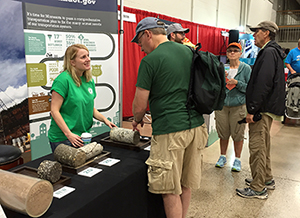
Serving our external customers: Liz Harens, Technology Investment Management, and Neal Younghans, Controller/Financial Management analyst, talk to visitors at the MnDOT booth Aug. 27 at the State Fair. Photo by Judy Jacobs |
The first phase of this effort will solicit input from our customers about their perceptions of our customer service from now through the end of 2016. Collecting this information for a Customer Service baseline should help us better understand how well we are interacting with our customers.
Beginning in 2017, phase two of the work to redefine customer service at MnDOT will be led by office directors and district engineers who will drill down into understanding how our respective offices and districts can improve our response to our customers.
We ask for your support and participation as we begin this process. Completing the surveys will take very little time and will help us collect valuable insight to help us understand where we are on our journey to earn trust and truly become a customer-centered organization. |
 |
|

|
 |
TABLE of CONTENTS
 |
WIG 2.0 leads to web updates |
By Kay Korsgaard, web and graphics supervisor
WIG 2.0 is off and running and so are requests for new or revamped websites. Many offices and units are including web revisions as a part of their WIG. As a result, long-neglected websites across the agency will soon be getting a new coat of paint and a new focus as offices look for ways to make their websites more customer focused and include ways to engage with their customers.
The Office of Communications web team is here to help. In addition to providing templates and a set of rules that provide guidelines for content and ensure that pages are accessible, the web team can help you build or rebuild pages to best meet your customers’ needs.
Here are a few tips to get you started:
- Keep your pages focused and organize your site around products and services. Your external customers, and even many of your internal customers, do not know or care about your office structure. They care about the services you provide.
- Focus on top tasks. What is it that people come to your website to DO? Make sure that those tasks are accessible from your home page.
- Avoid mission statements on the home page. Include this type of information on an “about” pages.
- Build with search in mind. More and more, our statistics show that people come directly to your page via Google or another search engine. The web team can help you review web statistics to build your sites around your customers’ needs.
- Build with accessibility in mind. This is a terrific opportunity to make sure that your web pages, and the documents that are linked from them, are fully accessible to all. This includes upgrading to templates that are functional on a mobile device, writing in plain language and following state and federal accessibility standards to comply with ADA.
Contact the web team at webteam.dot@state.mn.us before you start to make sure you have the latest templates and information. If you don’t have a webmaster for your office, we are here to help. |
 |
|
| |
|



